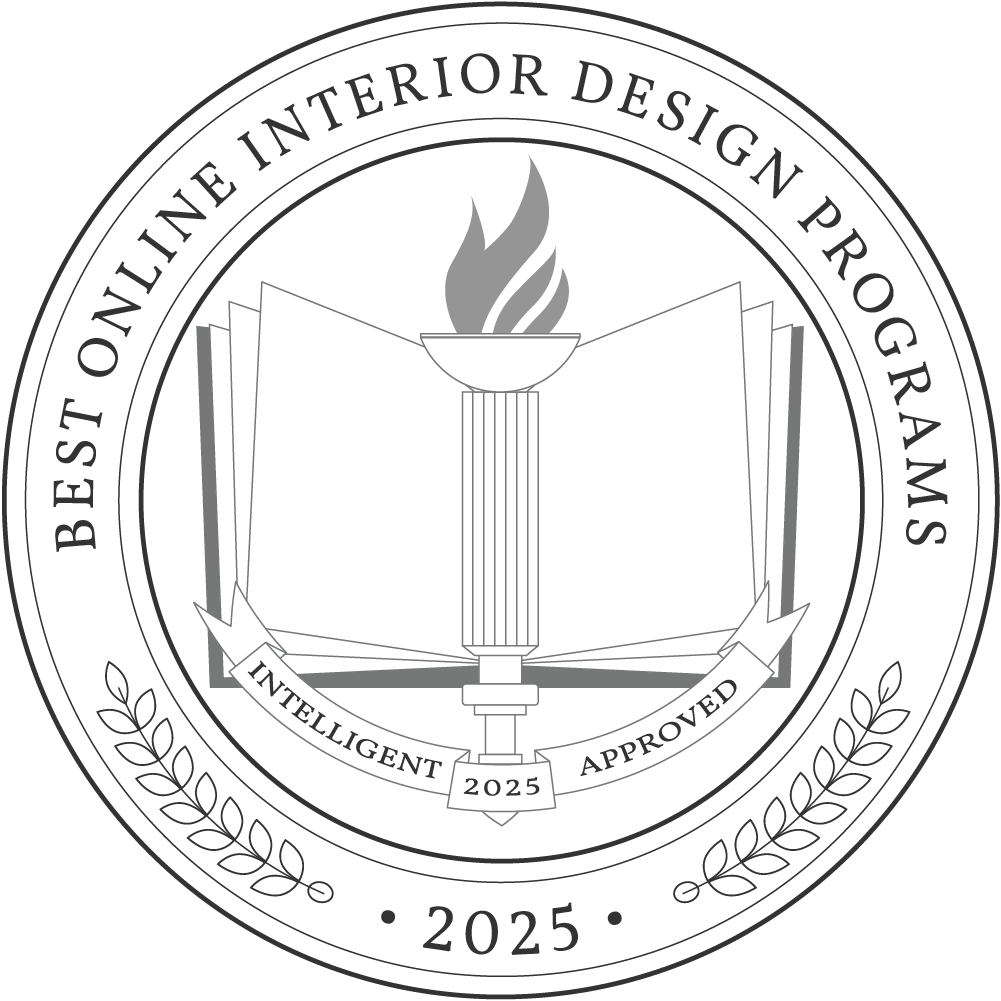An online interior design degree program equips students with the creative and technical skills needed to design functional and aesthetically pleasing indoor spaces. Graduates can pursue roles such as interior designer, space planner, and design consultant, with average salaries around $62,510 annually, according to the Bureau of Labor Statistics.
Typically, completing an online bachelor’s degree in interior design takes about four years of full-time study, covering approximately 120 credit hours. The cost of these programs varies widely; according to the National Center for Education Statistics, average annual tuition ranges from $9,000 to $38,000, depending on the institution.
Why Trust Us
The Intelligent.com Higher Education Team is dedicated to providing students with independent, equitable school and program rankings and well-researched resources. Our expert-driven articles cover topics related to online colleges and programs, paying for school, and career outlooks. We use data from the U.S. Department of Education’s College Scorecard, the National Center for Education Statistics, and other reputable educational and professional organizations. Our academic advisory team reviews content and verifies accuracy throughout the year for the most current information. Partnerships do not influence rankings or editorial decisions.
- Analyzed over 2,000 national, accredited, and nonprofit colleges and universities
- 800+ rankings pages are reviewed and updated yearly
- Content is informed by reputable sources, surveys, and interviews with academic advisors and other experts
- Over 100 data points are reviewed for accuracy and quality throughout the year, including sources
How we rank schools
Our list features the best online Interior Design degree programs at top colleges nationwide. Each school featured is a nonprofit, accredited institution — either public or private — with a high standard of academic quality for post-secondary institutions.
We evaluated each school’s program on tuition costs, admission, retention and graduation rates, faculty, reputation, and the student resources provided for online students. We collected data from trusted sources like the National Center for Education Statistics, individual school and program websites, school admissions counselors, and other data sources. Then, we calculated the Intelligent Score on a scale of 0 to 100 based on the following criterion:
Academic Quality:
- Admission rate versus enrollment rate
- Retention rate of students who return after year one
- Accreditation status (regional and programmatic)
- Nonprofit status, both private and public institutions
Graduation Rate
- Overall graduation rate
- Total number of currently enrolled students, including diversity metrics
- Student-to-faculty ratio
Cost and ROI
- In-state and out-of-state per-credit tuition rates and fees
- Required credits to graduate
- Earning potential after graduation
- Availability of federal student loans, scholarships, and other financial aid options
Student Resources
- Available student services for online-only and hybrid programs
- On-campus amenities like tutoring centers and the number of libraries
Read more about our ranking methodology.
Best 2 Accredited Online Interior Design Degree Programs
FiltersInstitution Type
Status
- Intelligent Score
- Alphabetically By University Name
- Acceptance Rate
- Enrollment
- In-state Graduate Tuition
- Out-of-state Graduate Tuition
- In-state Undergraduate Tuition
- Out-of-state Undergraduate Tuition

New York School of Interior Design
Intelligent Score: 98In-state: $71,950
Out-of-state: $71,950
In-state: $32,600
Out-of-state: $32,600
SAT: 1050-1300
ACT: 19-23
$1,300
Online, On-Campus
Council for Interior Design Accreditation
132

Ohio University
Intelligent Score: 96.56In-state: $27,574
Out-of-state: $38,254
In-state: $18,138
Out-of-state: $18,138
SAT: 1070-1290
ACT: 22-27
$304
Online
Council for Interior Design Accreditation
127
How to Choose an Online Interior Design Degree Program
Choose your area of study
Begin by exploring various specializations within the field, such as residential design, commercial design, sustainable design, or furniture design. Research each area to understand its specific job prospects, required skills, and industry demand. Assess your strengths and passions to determine which specialization resonates most with you. Consult industry professionals and academic advisors for insights and guidance. Review the curriculum of potential programs to ensure they offer courses and resources that match your chosen specialization.
Research schools and programs
Start by checking if the programs that look appealing to you are accredited by the Council for Interior Design Accreditation. Accreditation ensures the curriculum meets professional standards and enhances job prospects. Examine each program’s curriculum to see if it covers essential topics like design principles and computer-aided design (CAD). Look into faculty qualifications and their industry experience. Evaluate student support services, such as career counseling and portfolio development. Finally, compare tuition costs and financial aid options to find a program that fits your budget.
Prepare for tests and applications
Make sure you understand the specific admission requirements of each program you are applying to, which may include standardized tests like the SAT or ACT. Use study guides and practice tests to improve your scores. Gather necessary documents, such as high school transcripts and letters of recommendation from teachers or professionals who can attest to your skills and dedication. Craft a compelling personal statement that outlines your passion for interior design. Some programs may require a portfolio showcasing your design work. Completing these steps thoroughly and accurately demonstrates your preparedness and commitment.
Select your program
Look at the courses offered by your potential program to ensure they cover areas like design theory and CAD, which are essential for this field. Consider the faculty’s industry experience and the availability of student support services such as academic advising and career placement assistance. Review the program’s flexibility, especially if you need to balance studies with work or other commitments. Comparing tuition costs and available financial aid options is also crucial. Consider whether your chosen program offers classes synchronously or asynchronously. The latter may be a better choice if you have other significant professional or personal commitments.
Determine how you’ll pay for your degree
Determining how to finance your degree is crucial for managing costs and avoiding excessive debt. Start by completing the Free Application for Federal Student Aid (FAFSA) to determine your eligibility for federal grants, loans, and work-study programs. Research scholarships specifically for interior design students offered by schools, professional organizations, and private foundations. Look into state grants and institutional aid provided by your chosen program. Explore payment plans or employer tuition reimbursement programs if applicable. Consider the total cost, including tuition, fees, and materials, and create a budget to manage your expenses.
What Can You Expect From an Online Interior Design Degree Program?
Students can expect to learn about design principles, color theory, spatial arrangements, and the use of a broad range of materials and finishes. Courses will cover computer-aided design, 3D modeling, and other digital tools essential for design work. In addition, students are likely to study building codes, safety regulations, and sustainable design practices to ensure their designs are both beautiful and compliant with industry standards.
Typically, completing an online bachelor’s degree takes about four years of full-time study, encompassing around 120 credit hours. However, part-time options may extend the duration. Some programs may require in-person labs or residencies, where students can gain hands-on experience and collaborate with peers and instructors in a practical setting. These residencies, often scheduled during weekends or summer sessions, provide invaluable real-world insights and networking opportunities.
Online programs offer flexibility, allowing students to balance their studies with personal and professional commitments. They often include interactive projects, virtual studio work, and critiques to mimic the collaborative environment of traditional design studios.
Potential courses you’ll take in an online interior design degree program
- Design Principles and Elements. Introduces students to the core concepts of design, including balance, contrast, harmony and proportion. Students learn how to apply these principles to create aesthetically pleasing and functional spaces.
- Computer-Aided Design (CAD). Students gain proficiency in CAD software, a crucial tool for creating detailed and accurate design plans. They also learn how to produce technical drawings and 3D models, which are essential for visualizing and presenting design ideas to clients and contractors.
- Color Theory and Application. Explores the psychological and practical aspects of color in interior design. Students learn about color harmonies, the impact of light on color, and how to create effective color schemes for various types of spaces.
- Materials and Textiles. Introduces a wide range of materials and textiles used in interior design, including their properties, applications and sustainability considerations. The course covers selection criteria and the use of these materials to achieve desired aesthetics and functionality.
- Interior Lighting Design. Focuses on the principles and techniques of lighting design, an essential element of creating ambiance and enhancing the functionality of spaces. Students learn about different types of lighting, fixture selection, and the impact of lighting on mood and perception.
Online Interior Design Degree Frequently Asked Questions
How do I apply to an online interior design degree program?
To complete the online application form available on the program’s website, gather necessary documents, including high school transcripts, any prior college transcripts, and standardized test scores (SAT or ACT, if required). Prepare letters of recommendation from teachers or professionals who can attest to your skills and dedication. Some programs may also require a portfolio showcasing your design work to date. Craft a compelling personal statement outlining your passion for interior design and career goals. Before applying, schedule a meeting with an admissions counselor to discuss program specifics and admission criteria and ensure all application materials are accurately submitted.
How much does an online interior design degree cost?
The cost of earning an online degree varies widely depending on multiple factors. On average, tuition for online programs ranges from $9,000 to $38,000 per year, as reported by the National Center for Education Statistics. Additional costs may include fees for technology, online resources, and materials such as design software and textbooks. Online programs often offer savings on commuting and housing expenses compared to traditional in-person programs, though tuition rates can be comparable. Public colleges and universities generally have lower tuition rates than private institutions. Financial aid options, including grants, scholarships, and loans, can significantly offset costs.
How long does it take to earn an online interior design degree?
Earning an online degree typically takes about four years of full-time study, equivalent to approximately 120 credit hours. Part-time enrollment options are often available, allowing students to extend the duration based on their schedule and pace. Online programs offer flexibility in course delivery and scheduling, accommodating working professionals and those with other commitments. Compared to on-campus degrees, online programs may offer accelerated options or allow students to progress at their own pace.
Compare School Options
Related Degrees
- Art and Art History
- Interior Design
- Film
- Music
- Game Design
- Fashion
- Photography
- Graphic Design

